Imagine this: you're drowning in a sea of paperwork. Important documents are scattered across multiple folders or lost in the abyss of your email inbox. Sounds familiar? Then you're likely spending countless hours searching for files and dealing with version control nightmares.
What if I told you that you can streamline your document management processes, save time and boost productivity. Well, you can! Enter an Electronic Document Management System (EDMS).
According to Nucleus Research, 83% of companies reported positive returns from using EDMS. Also, organisations experienced a 50–90% reduction in processing time related to document handling.
So, in this blog, we'll learn about EDMSs, from their benefits to their key features. We'll help you understand why an EDMS isn't just a nice-to-have, but a must-have for any organisation looking to stay competitive and efficient in today's digital age.
Plus, we’ll bring you a step-by-step guide to build your own EDMS, because I promise, I don’t want you to miss out on the transformative power of EDMS.
Let’s dive in…
What is an EDMS?
An EDMS (Electronic Document Management System) is a software solution that helps organisations store, manage and track digital documents and images. It centralises files, controls access, tracks changes, automates workflows and ensures compliance with regulations. Essentially, an EDMS helps improve efficiency, collaboration and security in managing an organisation's documents.
EDMS vs. DMS: Is there a difference?
While the terms EDMS and DMS (Document Management System) are often used interchangeably, there's a subtle difference between them.
An EDMS is specifically designed to manage digital or electronic documents and images, focusing on features like digital storage, access control, version tracking and workflow automation for electronic files.
In contrast, DMS is a broader term that encompasses the management of both electronic and physical documents. It has all the features of an EDMS but also has features to track, store and manage physical records.
Examples of EDMSs
Some of the prominent examples of EDMs which organisations might use to arrange their documents are as follows:
- Microsoft SharePoint -is a widely-used platform that offers document management, collaboration and content management features.
- Zoho WorkDrive -cloud-based EDMS that provides document management, collaboration and file sharing features.
- Google Drive -primarily a cloud storage service, Google Drive also offers document management and collaboration features through Google Workspace.
Which industries can benefit from EDMS?
According to McKinsey, employees often spend 1.8 hours per day to 9.3 hours per week finding documents and information.
Thus, organisations across industries have implemented EDMSs to manage and organise these documents to find access to all the necessary information. Let’s look at the top industries which have implemented EDMS.
Businesses
Companies of all sizes implement EDMSs to manage their digital files efficiently. This helps them improve collaboration among teams, streamline workflows and enhance overall productivity of the team.
Let’s see how businesses can benefit from EDMS across domains:
Legal firms
Law firms use EDMSs to manage case files and legal documents. These systems ensure that important documents are securely stored and easily retrievable for legal proceedings.
Real Estate
Real estate agencies and property management firms use EDMS to manage lease agreements, property records and client documents. This enhances document organisation, simplifies transaction processes and ensures compliance with real estate regulations.
Human Resources
HR departments across various industries can use EDMSs to manage employee records, benefits information and compliance documents. This improves HR processes and facilitates regulatory compliance.
Construction
Construction companies can use EDMSs to manage project plans, contracts and compliance documents. This improves project management and ensures document security.
Retail
Retail businesses can use an EDMS to manage inventory records, sales documents and customer data. This enhances data management and improves operational efficiency
Government agencies
Government bodies use EDMSs to manage public records, ensuring compliance with regulations and improving transparency. These systems help in organising vast amounts of data, making it easier to retrieve and share information as needed.
Healthcare institutions
Hospitals, clinics and other healthcare providers use EDMSs to manage patient records securely, facilitating quick access to patient information. This ensures quick access to crucial information during emergencies and in following healthcare regulations.
Educational institutions
Schools, universities and other educational organisations use EDMSs to manage student records, administrative documents and educational materials. This helps in maintaining organised and easily accessible records, which is essential for administrative tasks and academic purposes.
What are the benefits of using an EDMS?
Here are some of the key advantages of using an EDMS:
1 - Improved organisation and accessibility
An EDMS centralises document storage, making it easier to organise, find and access files. This saves time and reduces the risk of losing important documents.
2 - Enhanced security
An EDMS provides robust security features like access controls, encryption and audit trails. This ensures that sensitive information is protected from unauthorised access and data breaches.
3 - Better collaboration
An EDMS allows multiple users to access and work on documents simultaneously, improving collaboration and communication among teams, especially in remote work settings.
4 - Efficient workflow management
EDMSs automate document-related processes like approvals, reviews and archiving. This streamlines workflows, reduces manual effort and improves overall productivity.
5 - Regulatory compliance
An EDMS helps organisations meet regulatory requirements by providing tools for document retention, disposal and audit trails. This is particularly useful in industries with strict compliance standards.
6 - Cost savings
Automating document management tasks can lower administrative costs by almost 40%. Also, the reduced need for physical storage, printing and manual document management can significantly lower operational costs.
7 - Disaster recovery
EDMSs typically includes backup and recovery features, ensuring that documents are protected and can be restored in case of data loss.
8 - Environmentally friendly
The paper industry is responsible for substantial deforestation, with over 40% of wood pulp being used for paper production. EDMSs directly addresses these environmental issues and contributes to an organisation's sustainability efforts.
9 - Scalability
An EDMS can easily scale to accommodate growing volumes of documents, making it a flexible solution for organisations of all sizes.
10 - Improved decision-making
With quick access to accurate and up-to-date information, EDMS supports better-informed decision-making processes.
Key EDMS features
Here are some key features commonly found in Electronic Document Management Systems (EDMS):
1 - Document storage and organisation
Centralised repository for storing and organising documents, often with folder structures and metadata tagging helps in easy document retrieval.
2 - Version control
Version control features in EDMSs like Document Control Softwares help track changes made to documents, allowing users to view and revert to previous versions if needed.
3 - Access Control
Granular permissions to control who can view, edit or delete documents, ensures data security and compliance.
4 - Search and retrieval
Advanced search capabilities, including full-text search, metadata search and filters, help to quickly locate specific documents.
5 - Workflow automation
Automates document-related processes like approvals, reviews and routing, streamlining workflows and improving efficiency.
6 - Collaboration tools
Features like document sharing, real-time editing and commenting facilitate collaboration among teams.
7 - Security and compliance
Encryption, audit trails and compliance tools ensure data protection and adherence to regulatory requirements.
8 - Integration
Seamless integration with other business applications, such as Custom Retail Management (CRM) and email systems, enhance overall productivity.
9 - Mobile access
Access to documents from mobile devices, allowing users to work on the go and stay connected.
10 - Backup and recovery
Automatic backup and recovery features protect against data loss and maintain continuity.
11 - Customisation
Customisable templates, forms and workflows tailor the system to specific organisational needs.
12 - Scalability
Ability to scale up or down based on the organisation's size and document volume, ensuring flexibility.
How to choose the right EDMS for your needs
Here’s an ultimate guide to help you in choosing the right EDMS for yourself.👇
Assess your Needs
Before diving into the market, it's crucial to understand your organisation's specific requirements. So, you should determine the volume of documents you need to manage and the number of users and their roles. Identify any industry-specific regulations or compliance needs that the EDMS must meet.
Define key features
Make a list of essential features your EDMS should have. This might include robust storage and strong security measures like encryption and access controls. These features help in facilitating team collaboration, such as real-time editing and collaboration.
Evaluate scalability
You should also consider the system's ability to scale with your organisation. As your business grows, you might need an EDMS that can handle increased document volume and user numbers without compromising performance. Look for a solution that offers flexible plans and can be easily upgraded to meet future demands.
Ease of use
A user-friendly interface is essential for quick adoption and efficient use. So, make sure that your system has an intuitive design that requires minimal training. The EDMS should be accessible to all users, regardless of their technical proficiency, to maximise productivity and minimise frustration.
Review vendor reputation
Research the vendor's reputation by reading customer reviews and testimonials. A reliable vendor will have a track record of providing excellent customer support and service. Check the frequency of updates and the vendor's commitment to ongoing maintenance to ensure the system remains up-to-date and secure.
Cost considerations
Compare pricing models to ensure the EDMS fits your budget. Look out for any hidden costs, such as additional fees for storage or user licences. Consider the long-term costs, including potential upgrades and maintenance, to make an informed financial decision.
Trial and demo
Get a hands-on feel for the system. This allows you to test its features and usability in a real-world scenario.
Build your own EDMS with Builder.ai in 8 easy steps
Building software for your business is a complex job that requires meticulous planning, expert development and continuous maintenance.
It also involves understanding intricate business processes, integrating various technologies and ensuring seamless user experiences.
All of these requirements would need a team of software engineers and a lot of time, which might not be cost-effective for your venture.
But, worry not!
As promised, we have brought you an EDMS — Builder.ai. Our platform shall cater to your unique and tailored business needs without writing a single line of code.
How does this happen?
Around 80% of all software is made up of around 650+ features. We package each basic feature as a reusable Lego-like block. Explain your idea to our AI companion, Natasha, and she uses these blocks to rapidly create an outline of your software.
The work is completed faster and cheaper because Natasha handles all the repetitive coding. Then it’s off to our software design team and software developers. They personalise it and create any bespoke elements you need.
To build your software, simply head over to Builder Studio. The Builder Studio platform has been built with user convenience in mind and intuitively guides you through the software creation process.
Here’s how you can build your custom software in no time 👇
Create robust custom software today
100s of businesses trust us to help them scale.
Book a demoBy proceeding you agree to Builder.ai’s privacy policy
and terms and conditions
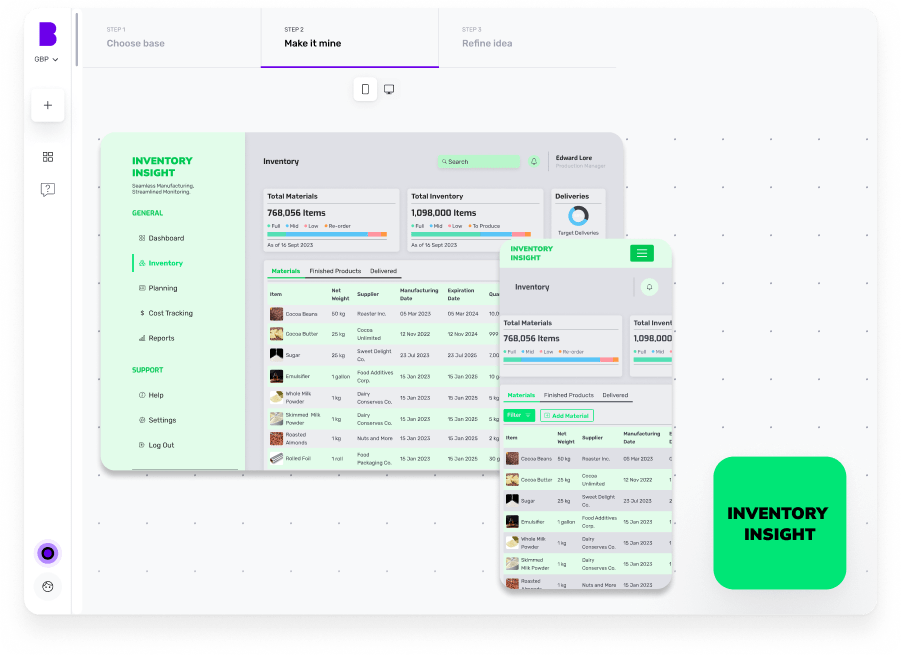
1 - Discuss your ideas with Natasha
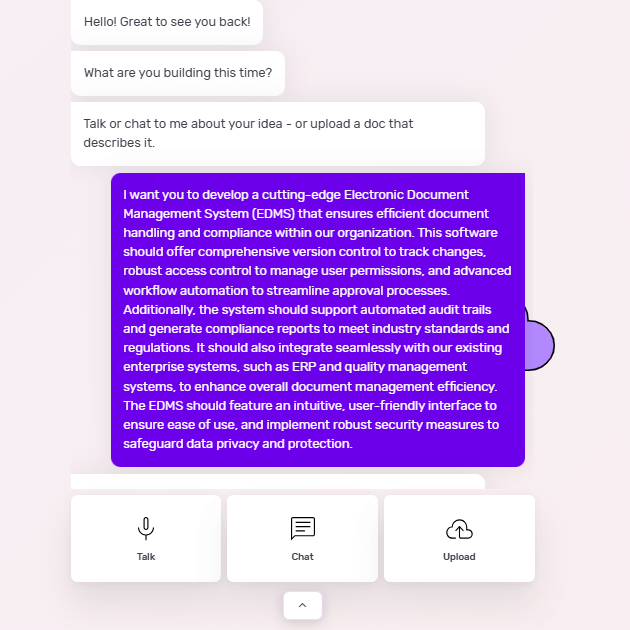
On Builder Studio 4.0, you’re welcomed by Natasha. You can express your software ideas to Natasha via voice, text or uploading a PDF or doc file.
Before you chat with her, have a checklist of software features and be as descriptive as possible about your software idea. The more detailed information you give Natasha, the better her suggestions will be.
For instance, if you’re building an EDMS, your prompt could look like this:
“I want you to develop a cutting-edge Electronic Document Management System (EDMS) that ensures efficient document handling and compliance within our organisation. This software should offer comprehensive version control to track changes, robust access control to manage user permissions and advanced workflow automation to streamline approval processes.
Additionally, the system should support automated audit trails and generate compliance reports to meet industry standards and regulations. It should also integrate seamlessly with our existing enterprise systems, such as ERP and quality management systems, to enhance overall document management efficiency. The EDMS should feature an intuitive, user-friendly interface to ensure ease of use, and implement robust security measures to safeguard data privacy and protection.”
Based on your prompt, Natasha will ask you some supporting questions and you simply need to answer them based on your requirements.
2 - Choose a base
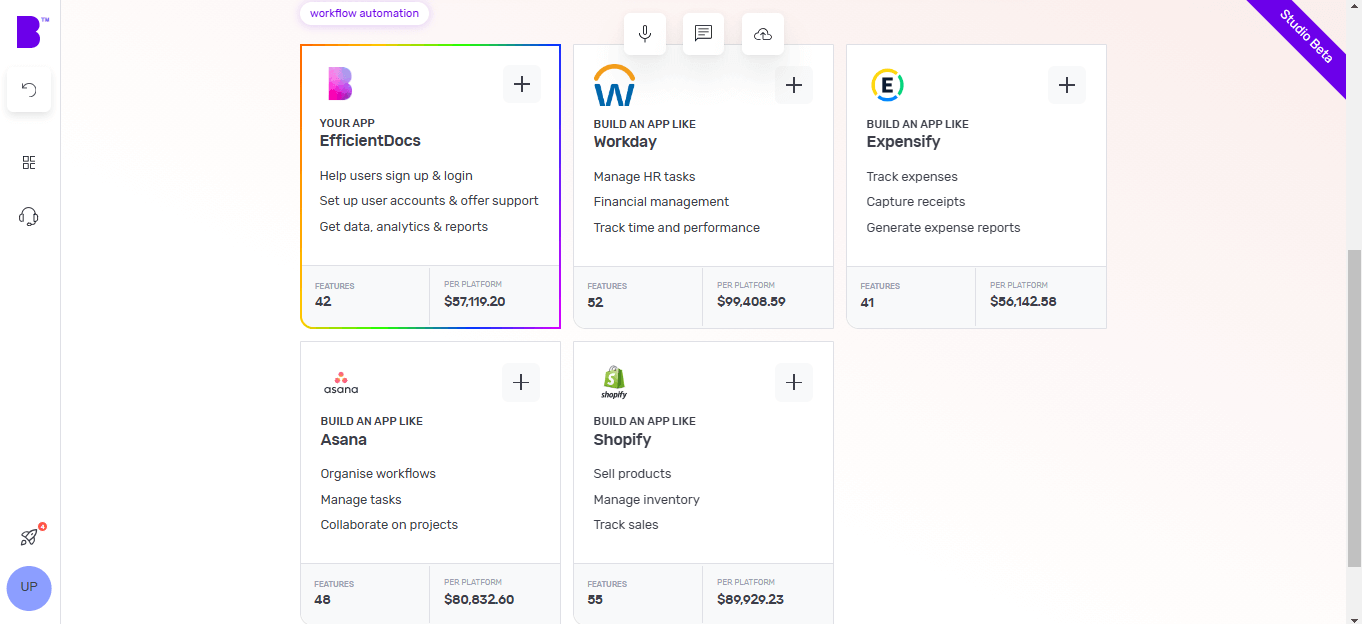
Once Natasha has your requirements, she’ll create a custom framework for your software based on everything you tell her. She'll also suggest some pre-built bases she thinks are best suited for your software.
Continuing from the above EDMS example, once you tell her to create an EDMS, she’ll suggest a custom base and share any matching core bases as well.
You can choose up to 3 you feel are related to your software idea by simply clicking the ‘+’ icon. These selections make it easier for us to understand the features your software needs. When you’re ready, click 'Next'.
3 - Make it mine
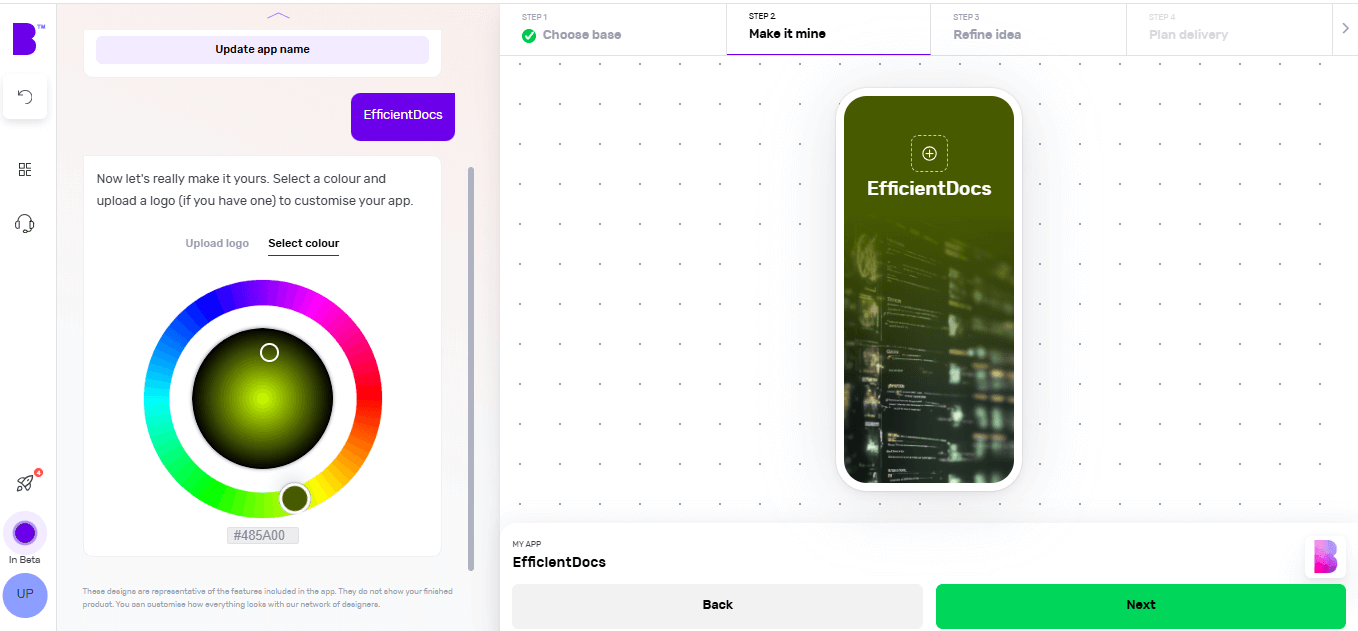
The 'Make it mine' step aligns your software with the identity of your brand. In this step, you provide your software’s name, choose the colour scheme using the colour wheel and upload the logo of your brand.
Once you’ve personalised your software’s name, colour and logo, you can click ‘Next’.
4 - Refine your software idea
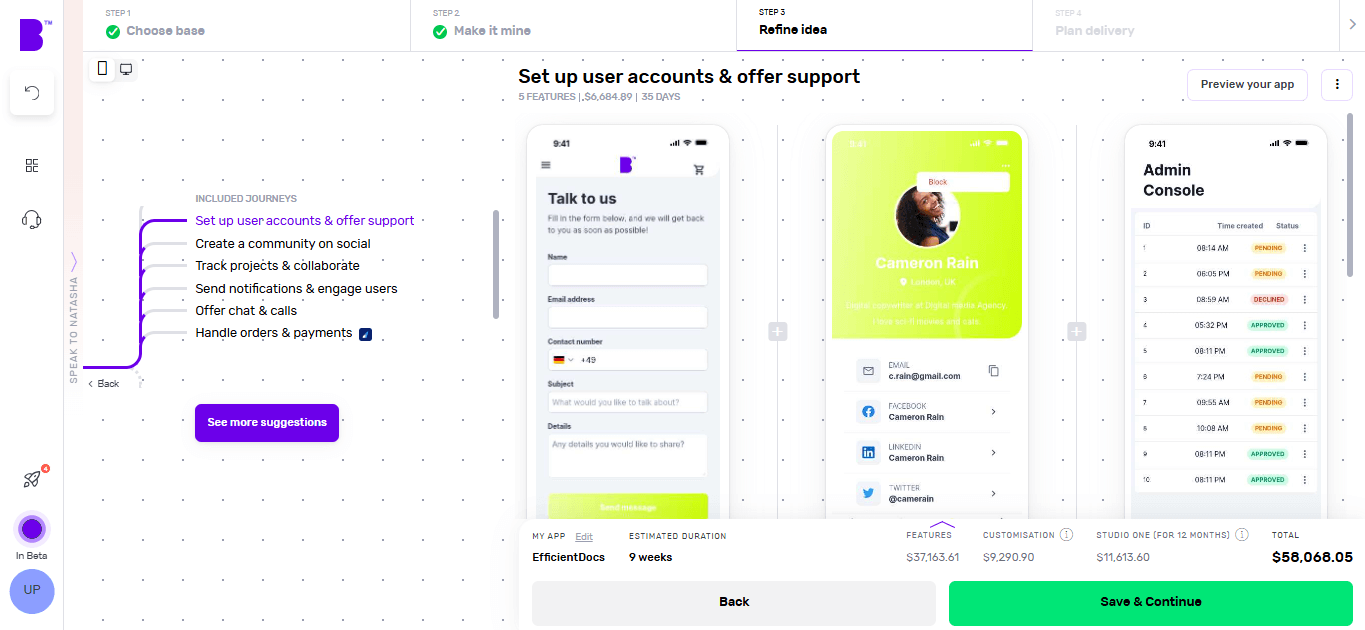
Now comes the fun bit.
In the 'Refine idea' stage, you can review and customise your software journeys and features and also create an instant prototype of your software.
Journeys
In only a matter of seconds, Natasha createssoftware user journeys with corresponding features.
Go through these journeys carefully and see if your software needs additional journeys. For instance, check if you want to add journeys for tracking logistics, customised order status or any other relevant journey.
To add journeys, click on 'See more suggestions'. Doing so will open the list of pre-built journeys. You can browse the list and select the journeys you’re missing. You can also add custom journeys by clicking on 'Add custom journey'.
Features
By clicking on individual journeys, you can see the feature list each journey contains. Doing so will open the features list each journey contains. You can scroll through the features list and check if a journey contains non-essential features or if you want to add extra features.
To remove a non-essential feature, you can hover over the feature and click ‘Remove’. This way you can manage project costs. If you’re not sure what features to remove, you can click on an individual feature and check the label at the top. We highly recommend keeping the ‘Essential Features’.
In case you want to add more features, you can simply click the ‘+’ button. Here you can go through different categories or use the search bar to look for missing functionality. In case you don’t find the feature you’re looking for, you can also add a custom feature by clicking on 'Add custom feature'.
Instant prototype and user flow
Once you’re happy with the journeys and features of your software, you can create a prototype by clicking on 'Preview your app' in the top-right corner.
Sign up and Natasha will create a working prototype of your software. You can click on the screen at different areas to progress through the journey.
You can also see theuser flow by clicking on the 'Flow mode' at the top of the screen to see how users will interact and navigate within your software.
If you need extra help, Natasha is on hand to help and you can interact with her at any time by clicking on 'Speak to Natasha'.
She’ll provide you with suggestions and help you find features or journeys from the library. Or you can click on 'Book a demo' to talk to our product managers who’ll guide you through your software development journey.
Click on 'Save & Continue' to go to the next step and also to save your progress or it might get lost.
5 - Plan delivery
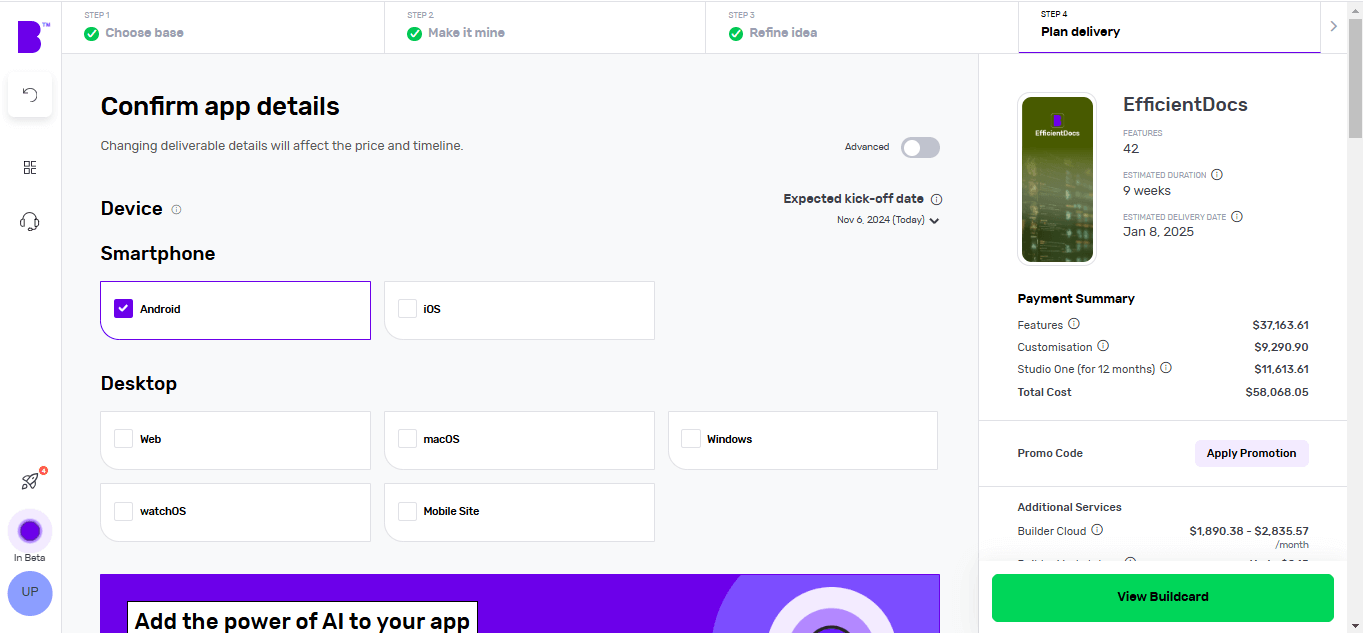
It’s time to choose the platforms you want your software to be available on. Want a desktop app? Click Windows or macOS. Fancy a mobile app? Hit Android or iOS. Not sure about the platform? Choose multiple platforms and see how they change the price and timelines.
Next, you can choose to add Natasha to your platform to supercharge the customer experience of your software. Natasha uses Large Language Models (LLMs) to engage your customers in fluid, human-like conversations.
In the development speed section, you can change the speed of each development phase according to your needs. The faster the development speed, the higher the costs and vice versa.
Next up is Design. If you have your software designs ready, you can save on your costs by clicking 'You have design' and we’ll reduce your costs accordingly. You can share your design files (preferably in Figma) and our designers will upload them, so you can kick them off straight away.
If not, you can choose the 'We do your designs' option. Here, you simply need to add your brand assets and we'll do everything from storyboarding to fully designed screens.
Now it’s time to plan the phases of your project. Here you get 3 options:
- Clickable prototype: you’ll get a visual representation of your software to test with users
- Basic build: you’ll get an MVP (Minimum viable product) – a hard-coded but simplified version of your idea — this allows you to collect feedback and iterate before you do a full build
- Full Build: you’ll get market-ready software, including a kick-off with our product team and review sessions
After that, you need to select your support plans. With 'Full Build' you get one year of Studio One support included free of charge.
Once you’ve planned your delivery, click on 'View Buildcard'.
6 - Review Buildcard
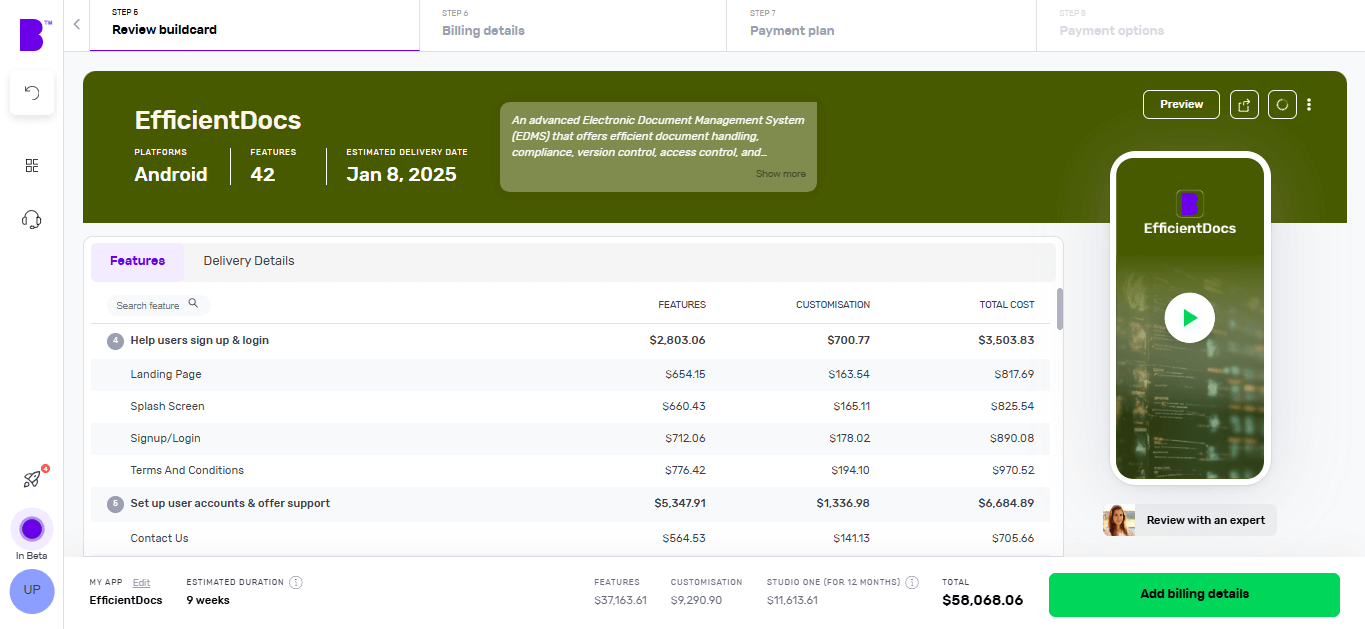
Buildcard provides you with a bird's eye view of all the selections you made in the previous steps. Here, you can review all the features, cost per feature and delivery details.
You can also download the PDF of Buildcard or invite others to show your team members what you’re building.
If you want to make any changes, simply click on 'Edit Buildcard' under the 3 dots in the top-right corner.
If you’re happy with everything, click on 'Add billing details' to go to the next section. Alternatively, if you want to review it with experts, click on 'Review with an expert'.
7 - Select your payment plan
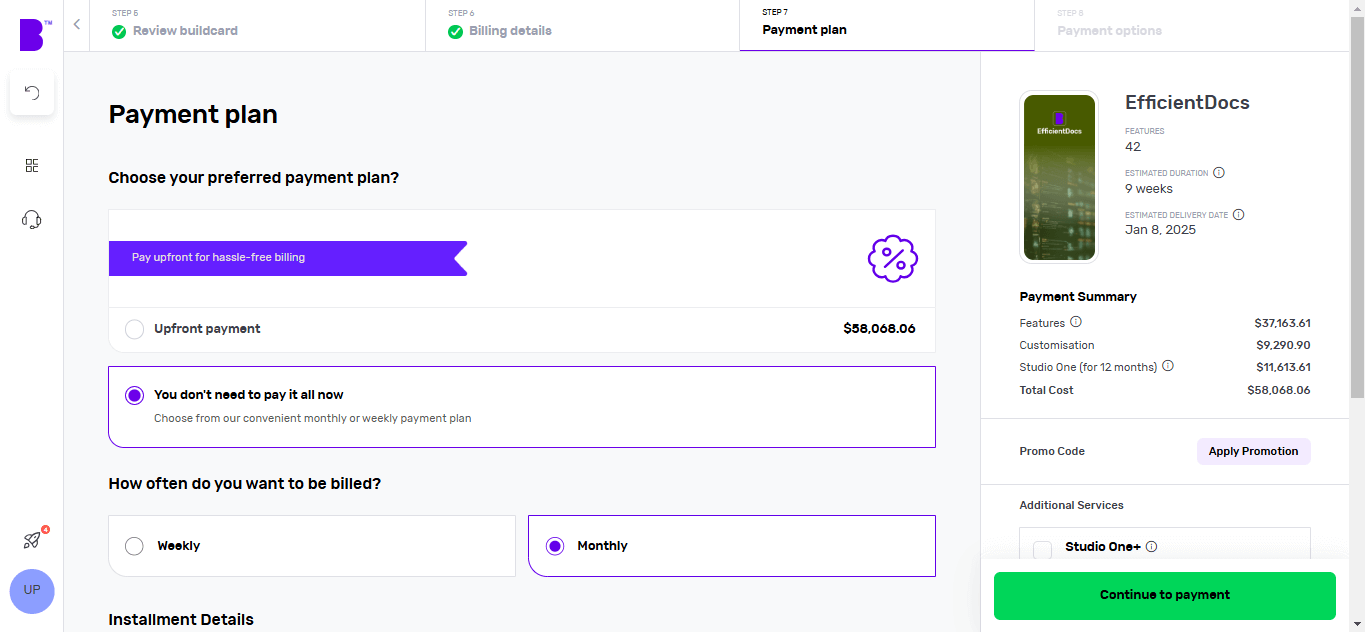
We offer weekly or monthly payment instalments, with visible payment dates and amounts for each option. You can also choose to pay upfront to reduce the cost of your build.
Simply select your preferred billing cycle, then click 'Continue' to proceed.
You’ll be asked to input your payment details and agree to the terms and conditions. Once that’s done, click 'Continue to Payment'.
Once your payment is done, you can set up a meeting with our product managers to begin your software development.
8 - Monitor your software build in real-time
With Builder Home, your real-time project dashboard, you can monitor development progress and make sure your software is exactly the way you want it.
This includes access to a suite of collaboration tools to help improve your software design. You can chat with your team of experts in Builder Meet, brainstorm in Builder Whiteboard and visualise your ideas with free Tailor-made prototypes from Builder Now.
Conclusion
If you struggle with managing multiple versions of documents on a regular basis and find it hard to organise your business documents, you need to build an EDMS.
However, to do this, you need to work with the best in the industry to build a high-quality EDMS.
Builder.ai’s custom software platform helps you build your software efficiently. We:
✅ Assign you a dedicated project manager, who keeps all stakeholders on your software project aligned and on track — and you never need to speak to a software developer or write a single line of code
✅ Speed up development time by giving you access to a comprehensive library of reusable features, fitted together by AI
✅ Give you upfront costs and competitive timelines so your project stays under control
If that’s something you’d like to explore, click the banner below to start your EDMS project today 👇
Create robust custom software today
100s of businesses trust us to help them scale.
Book a demoBy proceeding you agree to Builder.ai’s privacy policy
and terms and conditions

Harsh Priya is a writer at Builder.ai. She has over 3 years of experience in content marketing, spanning across fields like AI, Machine Learning, software, tech, health and lifestyle. With a background in English literature and a fervent passion for research and analysis, Harsh transforms complex concepts into compelling and insightful narratives that educate and drive significant reader engagement.

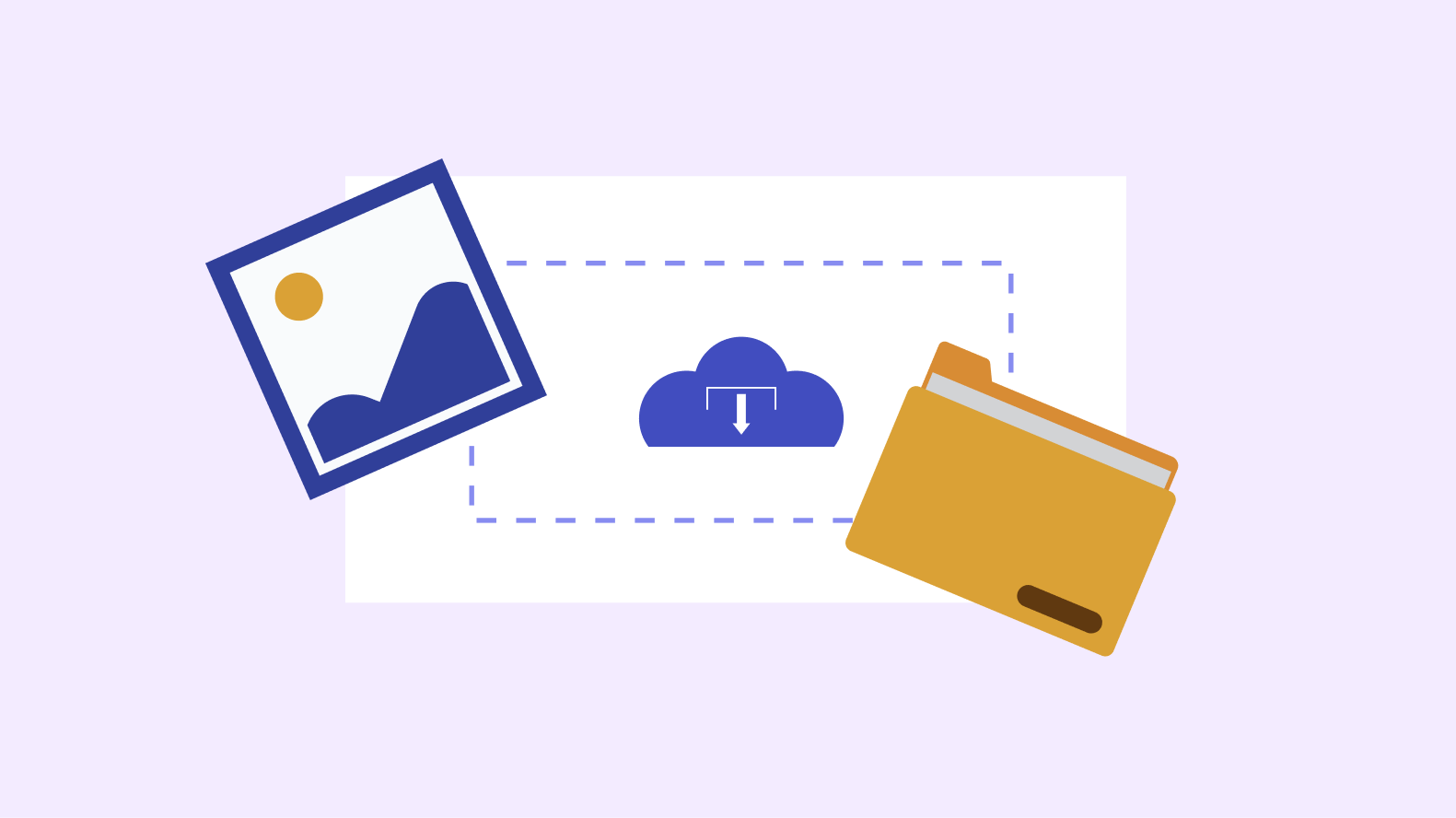








 Facebook
Facebook X
X LinkedIn
LinkedIn YouTube
YouTube Instagram
Instagram RSS
RSS


